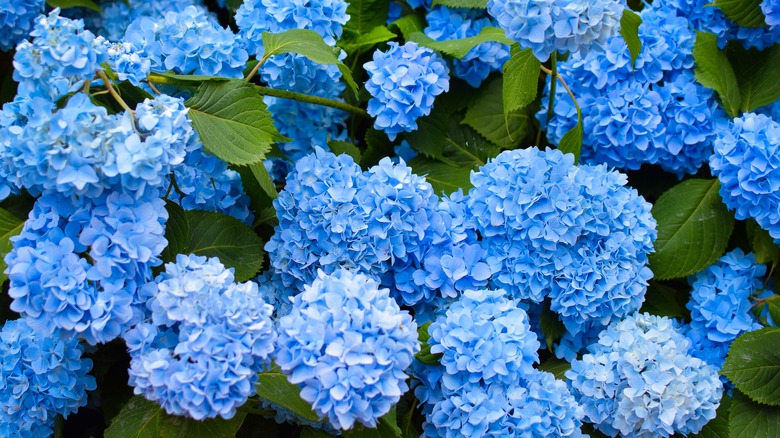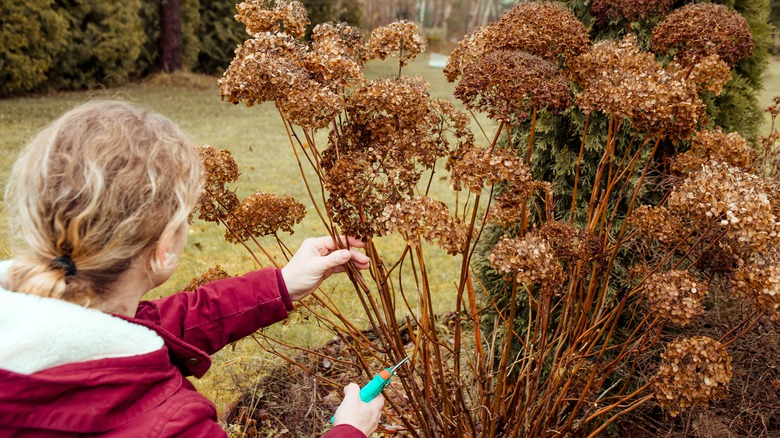Our Gardening Expert Explains What A Dormant Hydrangea Really Looks Like Before Coming To Life In The Spring
To the untrained eye, a dormant hydrangea looks extremely similar to a dead hydrangea. So much so, that it's a safe bet that many people have erroneously believed that their plant didn't make it through the winter, only to pull it up and throw away a perfectly good specimen. Because a hydrangea is a terrible thing to waste, House Digest consulted Rhonda Kaiser, founder and content creator behind Southern Home and Farm, for her exclusive insight into the specifics of hydrangea health.
Hydrangeas are well-loved for their large blooms that come in an array of colors. When they're dormant in the winter, however, they more closely resemble a collection of sticks. "Although they may appear lifeless during this time, they are most likely simply 'sleeping,'" Kaiser explains. In fact, as long as you plant a type that is suitable for your particular climate (also known as your hardiness zone) and take care of the hydrangea, chances are good that it'll survive to spring again and again. Eventually, you'll become quite the expert at identifying dormant hydrangeas with merely a glance.
How to tell if a hydrangea is dead or dormant
Dormant hydrangeas are about as unattractive as blooming hydrangeas are beautiful. Because of this, it's no wonder so many are mistaken as dead! Fortunately, it's not difficult to figure out which category a sorry-looking hydrangea falls into. For the best and most reliable assessment, Rhonda Kaiser exclusively tells House Digest to conduct a quick check in March or April. "You can either wait to see if new growth appears or gently scratch with your thumbnail to the cambium layer (the layer just beneath the bark)," she explains. "If you see a greenish hue, your plant is still alive."
If the plant is alive, it's just a matter of time before it starts to leaf out, and then those ubiquitous ball-shaped blooms will eventually appear on their own particular schedule. If you determine that it's not simply dormant, however, it should be easy enough to pull out of the ground. If it was planted recently it may still be under warranty, depending on where it was purchased. Some stores do require a receipt and the physical plant to replace or refund it, however, so make sure you understand the warranty terms before tossing anything in the trash.
Follow these guidelines to help your hydrangea thrive
Much like other plants, hydrangeas do best when they're given some TLC, and Rhonda Kaiser gave House Digest exclusive tips on how to prepare your hydrangeas for the winter. First, she says that hydrangeas should be watered until the first frost of the season. "The key is to keep the soil moist," Kaiser explains. After the frost, you can lighten up. "By the time your hydrangeas become dormant, rain or snow will suffice," she says.
However, make sure hydrangeas are toasty warm for the cold season. "Protect them from the elements (once the leaves fall off) with a thick layer of mulch," Kaiser says. If the hydrangeas are in containers she says to place them in a garage until springtime returns. "Water monthly until spring to keep them viable," she adds.
Pruning is also a good idea, but Kaiser says not to do this until spring for most varieties. "Leaving old growth can also protect the plants during winter," she says, noting that some varietals like Big Leaf Hydrangeas "can bloom on old wood from last year." If that's the case, pruning may not even be necessary! If you do prune them, make sure to only cut dead stems at a 45-degree angle using a set of sharp, clean pruning shears, she suggests. "This helps prevent spread of disease (i.e. bacterial, fungal, or viral pathogens) and cross-contamination to other plants," Kaiser explains. Following these simple guidelines will hopefully result in dormant, not dead hydrangeas year after year!


